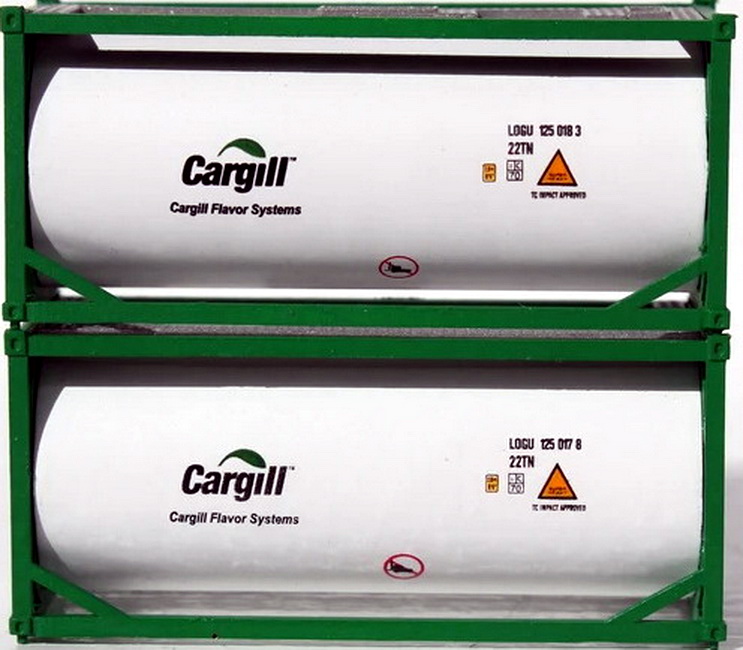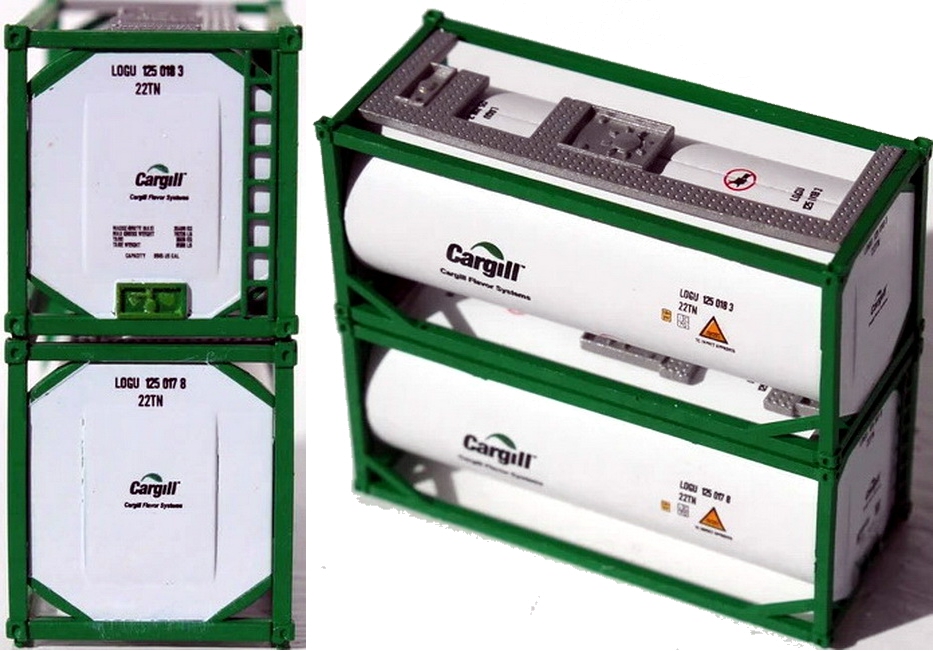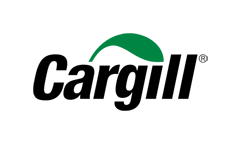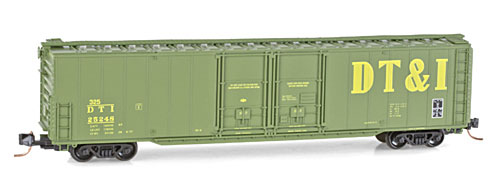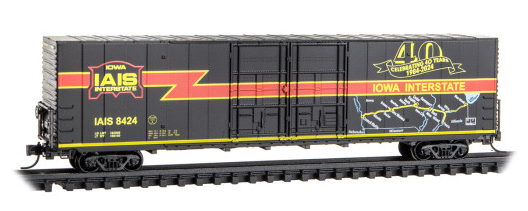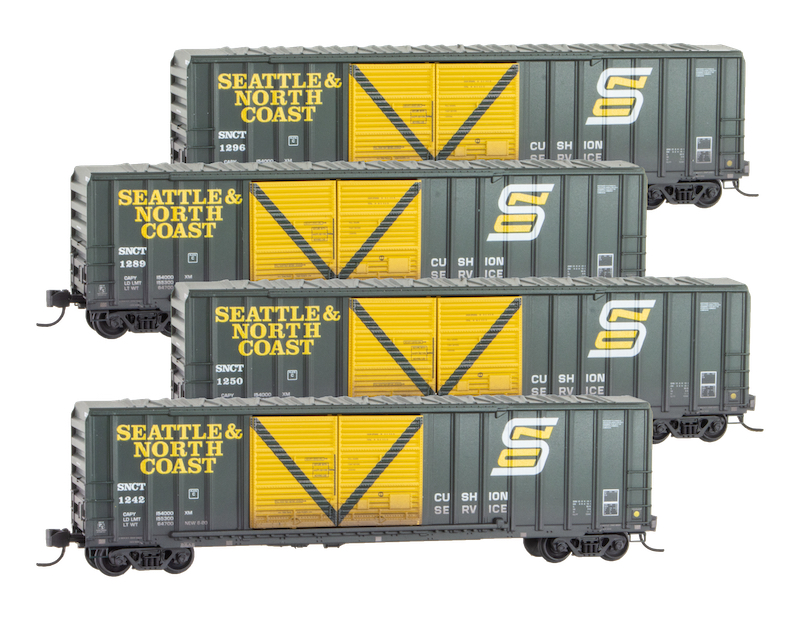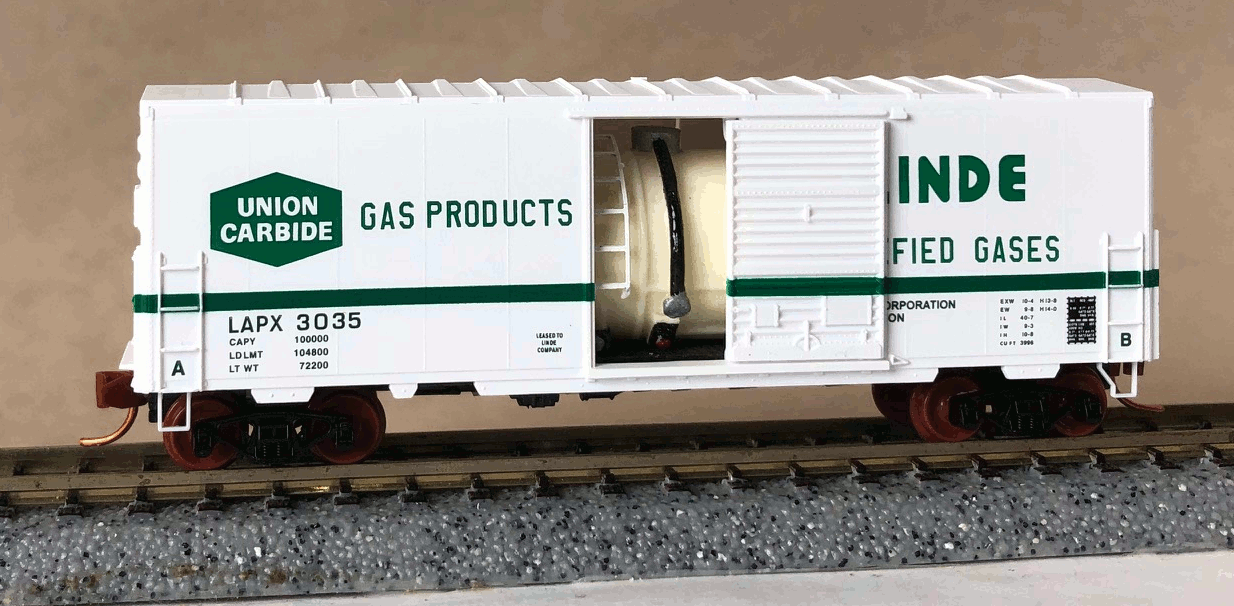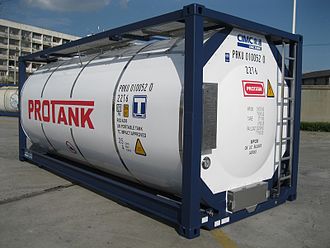Specific Item Information: CARGILL 20' Standard Tank Container (full length 3/4 around walkway)
Cargill Flavor Systems has well-established international flavor technology development expertise that serves customers globally with flavor ingredients and flavor systems for beverage, dairy, sweet and savory applications. The business has long-standing relationships with other global food and beverage manufacturers and employs 700 people through its development and application centers in France, the UK, South Africa, India, Malaysia, China, the US, Puerto Rico, Mexico and Brazil, which is in turn supported by a network of sales representative offices in 12 other countries around the world..
Numbers 1250183, 1250178
Numbers 1250183, 1250178
Model Information: These are also finely detailed, delicate miniatures with scales frames and details. Rules for Tank container transport provides for transport in the bottom of well cars, and on flatcars. If the tank container has hazardous liquid it should Not have another container stacked on top of it (look for Hazard label). If non-hazardous, other containers can be stacked on top. Tank containers do not ship double stacked in the Top position.
Model Features:
IBC 'PIN' and holes for stacking
Multiple walkway configurations to match prototypes
Etched metal end ladder
When required - mechanical unit (Heat / Cool) and Placard/Tool box as per prototype picture.
Precise printing as per prototype
These do not have a magnet on bottom, as they do not ship stacked on top of another container.
Model Features:
IBC 'PIN' and holes for stacking
Multiple walkway configurations to match prototypes
Etched metal end ladder
When required - mechanical unit (Heat / Cool) and Placard/Tool box as per prototype picture.
Precise printing as per prototype
These do not have a magnet on bottom, as they do not ship stacked on top of another container.
Prototype History: A tank container is built to the ISO standards, making it suitable for different modes of transportation. Both hazardous and non-hazardous products can be transported in tank containers.
The tank container concept was also employed in Europe by Bob Fossey, an engineer who worked for Williams Fairclough in London. They improved on the 1950s framed American elliptical container tanks, oft noted carrying specified USA engine oils for the UK’s MoD aircraft built in Preston, Lancashire.
In 1964 Fairclough made a swap body tank for combined transport by truck and train, but not yet constructed according to ISO standards.
In 1966, commercial production began and one year later the first tank container to ISO dimensions was developed. The first mass-produced tank containers were purchased by Trafpak, a part of Pakhoed.
Rules for Tank container transport provides for transport in the bottom of well cars, and on flatcars: if the tank container has hazardous liquid it should Not have another container stacked on top of it (look for Hazard label). If non-hazardous, other containers can be stacked on top. Tank containers do not ship double stacked in the Top position.
The tank container concept was also employed in Europe by Bob Fossey, an engineer who worked for Williams Fairclough in London. They improved on the 1950s framed American elliptical container tanks, oft noted carrying specified USA engine oils for the UK’s MoD aircraft built in Preston, Lancashire.
In 1964 Fairclough made a swap body tank for combined transport by truck and train, but not yet constructed according to ISO standards.
In 1966, commercial production began and one year later the first tank container to ISO dimensions was developed. The first mass-produced tank containers were purchased by Trafpak, a part of Pakhoed.
Rules for Tank container transport provides for transport in the bottom of well cars, and on flatcars: if the tank container has hazardous liquid it should Not have another container stacked on top of it (look for Hazard label). If non-hazardous, other containers can be stacked on top. Tank containers do not ship double stacked in the Top position.
Road Name History: Cargill, Inc. is an American privately held global corporation based in Minnetonka, Minnesota, a Minneapolis suburb. Founded in 1865, it is now the largest privately held corporation in the United States in terms of revenue. If it were a public company, it would rank, as of 2015, number 12 on the Fortune 500, behind McKesson and ahead of AT&T.
Some of Cargill's major businesses are trading, purchasing and distributing grain and other agricultural commodities, such as palm oil; trading in energy, steel and transport; the raising of livestock and production of feed; producing food ingredients such as starch and glucose syrup, vegetable oils and fats for application in processed foods and industrial use. Cargill also operates a large financial services arm, which manages financial risks in the commodity markets for the company. In 2003, it split off a portion of its financial operations into a hedge fund called Black River Asset Management, with about $10 billion of assets and liabilities. It owned 2/3 of the shares of The Mosaic Company (sold off in 2011), one of the world's leading producers and marketers of concentrated phosphate and potash crop nutrients.
Cargill declared revenues of $136.7 billion and earnings of $2.31 billion in the 2013 fiscal year. Employing over 140,000 employees in 66 countries, it is responsible for 25% of all United States grain exports. The company also supplies about 22% of the US domestic meat market, importing more product from Argentina than any other company and is the largest poultry producer in Thailand. All of the eggs used in McDonald's restaurants in the US pass through Cargill's plants. It is the only producer of Alberger process salt in the US, which is used in the fast-food and prepared food industries.
Cargill remains a family-owned business, as the descendants of the founder (from the Cargill and MacMillan families) own over 90% of the company.[8] As a result, most of its growth has been due to reinvestment of the company's own earnings rather than public financing. Gregory R. Page, who is not part of either the Cargill or MacMillan families, is the executive chairman of Cargill. He succeeded former CEO Warren Staley in mid-2007, as Staley reached Cargill's mandatory retirement age of 65, before he in turn was succeeded by Dave MacLennan.
From Wikipedia
Some of Cargill's major businesses are trading, purchasing and distributing grain and other agricultural commodities, such as palm oil; trading in energy, steel and transport; the raising of livestock and production of feed; producing food ingredients such as starch and glucose syrup, vegetable oils and fats for application in processed foods and industrial use. Cargill also operates a large financial services arm, which manages financial risks in the commodity markets for the company. In 2003, it split off a portion of its financial operations into a hedge fund called Black River Asset Management, with about $10 billion of assets and liabilities. It owned 2/3 of the shares of The Mosaic Company (sold off in 2011), one of the world's leading producers and marketers of concentrated phosphate and potash crop nutrients.
Cargill declared revenues of $136.7 billion and earnings of $2.31 billion in the 2013 fiscal year. Employing over 140,000 employees in 66 countries, it is responsible for 25% of all United States grain exports. The company also supplies about 22% of the US domestic meat market, importing more product from Argentina than any other company and is the largest poultry producer in Thailand. All of the eggs used in McDonald's restaurants in the US pass through Cargill's plants. It is the only producer of Alberger process salt in the US, which is used in the fast-food and prepared food industries.
Cargill remains a family-owned business, as the descendants of the founder (from the Cargill and MacMillan families) own over 90% of the company.[8] As a result, most of its growth has been due to reinvestment of the company's own earnings rather than public financing. Gregory R. Page, who is not part of either the Cargill or MacMillan families, is the executive chairman of Cargill. He succeeded former CEO Warren Staley in mid-2007, as Staley reached Cargill's mandatory retirement age of 65, before he in turn was succeeded by Dave MacLennan.
From Wikipedia
Brand/Importer Information: Now featuring our new line of 1:160 scale models. Developed using the latest in global technology & CAD systems, these New 2017 tooled models feature IBC connecting pins AND our Magnetic connecting system, and are decorated with detailed prototype printing. Our JTC container series of models offer Multiple door styles and variants to match prototypes. The First release is a 'Rib-style' corrugated side Canvas/Open top container, Now In Stock. Our second release is the more common 'wave' corrugation sides version, expected January 2018. Both are New to N scale. Release styles 3 & 4 will be around March 2018, and will be 2 of the most popular container styles in use. Please read our 'Latest News' section for updates. Thank You for visiting. New Facebook page: www.facebook.com/JTCmodeltrains
Item created by: CMK on 2020-03-01 09:41:34. Last edited by Lethe on 2020-05-07 00:00:00
If you see errors or missing data in this entry, please feel free to log in and edit it. Anyone with a Gmail account can log in instantly.
If you see errors or missing data in this entry, please feel free to log in and edit it. Anyone with a Gmail account can log in instantly.


